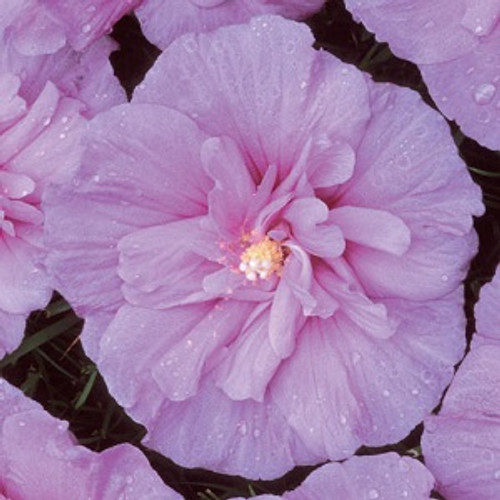| Hibiscus s. 'Rwoods6' | USDA Zone: 5-9 |
Starblast Chiffon brilliant white flowers has a fluffy doubled center, highlighted by a dramatic hot pink starburst center. It has the same nicely rounded habit as the other members of the Chiffon® series, perfect for using in a border or as a specimen.
Top reasons to grow Starblast Chiffon® Rose of Sharon:
- Reliable summer flowers
- Long bloom period
- Interesting color show
Starblast Chiffon Rose of Sharon is recommended for the following landscape applications;
- Accent
- Mass Planting
- Hedges/Screening
- General Garden Use
- Container Planting
Bloom Time: Summer, Fall
Attracts: Bees, Butterflies, Hummingbirds
Long Bloomer
Deer Resistant
Salt Tolerant
Low Maintenance
Common Name: Rose of Sharon, Shrub Althea
|
Key Feature
|
Light Needs | Landscape Uses |
 |
 |
|
|
|
|
| More About Starblast Chiffon Rose of Sharon |
| Height: 8-12 ft |
Spread: 5-8 ft |
Flower Colour: White / Pink Shades |
|
Starburst Chiffon Rose of Sharon does best in full sun to partial shade. It prefers to grow in average to moist conditions, and shouldn't be allowed to dry out. To help this plant achive its best flowering performance, periodically apply a flower-boosting fertilizer from early spring through into the active growing season. It is not particular as to soil type or pH. It is highly tolerant of urban pollution and will even thrive in inner city environments. Consider applying a thick mulch around the root zone over the growing season to conserve soil moisture. Use as the centerpiece of large container designs or incorporate into mixed borders in the landscape. Good for hedging. Little needed. Prune as needed to shape in early spring. Apply a controlled release fertilizer for shrubs in spring. Supplemental liquid fertilizer may be needed in mid-summer. Starblast Chiffon Rose of Sharon makes a fine choice for the outdoor landscape, but it is also well-suited for use in outdoor pots and containers. Its large size and upright habit of growth lend it for use as a solitary accent, or in a composition surrounded by smaller plants around the base and those that spill over the edges. It is even sizeable enough that it can be grown alone in a suitable container. Note that when grown in a container, it may not perform exactly as indicated on the tag - this is to be expected. Also note that when growing plants in outdoor containers and baskets, they may require more frequent waterings than they would in the yard or garden. Be aware that in our climate, most plants cannot be expected to survive the winter if left in containers outdoors, and this plant is no exception. NOTE: Some flowers and plants may be harmful or poisonous to people or pets if touched or ingested. If you require more information before placing an order, please let us know in advance. |











